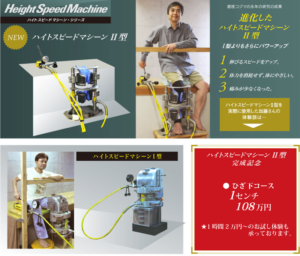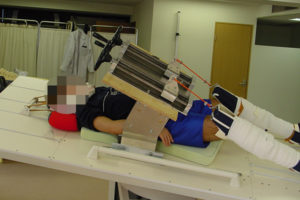Natural Height Growth has written about Ginza Kojima’s devices before. The device appeared to be some kind of traction device with a rotational force applied. The centripetal force could potentially stretch the body. But all these forces ultimately have to lead to some kind of plastic deformation(permanent stretch of the bone or cartilage). I speculated previously that the green light may be some kind of radiation that weakens the bone which allows it to be permanently stretched.
Here’s Ginza Kojima’s new website: http://www.shincho-nobashi.jp/
 It looks like it applies a rotational/twisting force on the leg combined with some kind of pressure.
It looks like it applies a rotational/twisting force on the leg combined with some kind of pressure.
It looks like it’s mainly for small amounts of height as taken by this excerpt below.
”
In the case of the whole body course (guarantee course), it is 500,000 yen up to 1 cm, 1,300,000 yen up to 2 cm, and 2,300,000 yen up to 3 cm. (Excluding tax ※ Consumption tax will apply separately)
In the case of the knee and foot bone course (guarantee course), it is 1 million yen to 1 cm, 2 million yen to 2 cm and 3 million yen to 3 cm. (Excluding tax ※ Consumption tax will apply separately)
Please inquire for detailed charges for 3 cm and beyond.”
One limb length testimonial though advertised in the site is for 5 cm which you cannot realistically achieve without actual major bone growth.
”
The effects of the treatment are very individual differences and it is not known how long it will take without actually starting the treatment.
In our hospital, we guide you to receive the treatment once a week 24 times (about 6 months) as a rough guide. In addition, we offer a course that you can receive intensive treatment for a week as a short-term intensive course, so please consult with distant people.”
<-so looks like once a week for 6 months.
The current treatment schedule at our hospital is as follows.
- 1st time 10:00 to 12:00 (30 minutes set time)
- Second time 12:30-14:00
- Third time 14:30-16:00
As mentioned above, an average of 3 sets is given daily. The second and subsequent treatments are basically the same, but we will make adjustments to suit your convenience as much as possible, so please contact us.”<-and 3 sessions of 30 minutes.
This machine advertised elsewhere on the site looks like a traction machine
Gina kojima explains the science behind his thinking here:
“First of all, I thought it would be good to pull. When I grabbed the bones of the foot from both sides and pulled it with a slight force according to the tug of war and the principle of childhood, I thought that it would be fine because the blood vessels became thinner and blood flow would improve. The heart is pumping 6 liters of blood a minute, so the blood vessels become thin if you pull a round blood vessel, and it is the theory that so much pressure will be applied to improve blood flow. It has been 40 years since I started making machines. To be honest, it will be dozens already. Anyway, it is said that if you look at it, why do you spend so much money to make stupid tools, and it keeps making it anyway.”
So this quote makes it seem like a traction device but a lot of traction devices don’t necessarily pull the bone to induce plastic deformation.
As far as traction devices go, you have to either induce plastic deformation in the bone or you have to stimulate the body to grow.
I think the whole body course is the traction machine and the knee course is the elevated height speed machine 2 device.
I think elevated height speed machine 2 device may just be another traction device but specifically for the knee. Any japenese translators?

